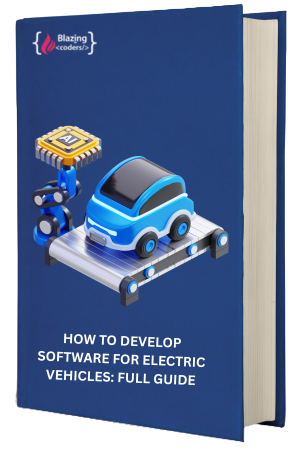How to Develop Software for Electric Vehicles: Full Guide
Explore a complete guide to EV software development including BMS, VCU, and telematics. Powered by Blazingcoders, your expert in intelligent EV solutions..

Electric Vehicles (EVs) are transforming the automotive industry. As the world pivots towards sustainable transportation, software plays a pivotal role in enabling performance, safety, connectivity, and energy efficiency in EVs. This complete guide outlines the essential steps, technologies, and strategies needed to develop powerful EV software—brought to you by Blazingcoders, your trusted tech partner in intelligent mobility solutions.
1. Introduction to EV Software Development
Electric vehicles rely heavily on embedded systems and cloud-integrated platforms to function effectively. Unlike traditional vehicles, EVs demand intelligent software for battery management, charging infrastructure, navigation, driver assistance, vehicle diagnostics, and user interface design.
Key Modules in EV Software:
-
Battery Management System (BMS)
-
Charging Management
-
Vehicle Control Unit (VCU)
-
Telematics and Connectivity
-
In-Vehicle Infotainment (IVI)
-
Predictive Maintenance
-
Driver Assistance & Safety Systems
2. Why EV Software Development Matters
The software layer in EVs is just as important as the hardware. Here's why:
-
Efficiency: Optimizes energy consumption through smart algorithms.
-
Safety: Real-time diagnostics prevent hazards and accidents.
-
User Experience: Seamless interfaces, smart features, and updates improve engagement.
-
Connectivity: Enables over-the-air (OTA) updates, navigation, and remote control.
-
Compliance: Meets government and global regulations.
3. Planning the EV Software Architecture
Start with a modular software architecture to ensure scalability and maintainability.
Core Components:
-
Embedded Layer: Low-level code written in C/C++ for ECU, BMS, and VCU.
-
Middleware: Communication protocols (CAN, LIN, Ethernet).
-
Application Layer: Android/Linux-based infotainment and dashboard features.
-
Cloud Services: Real-time data syncing, remote monitoring, OTA updates.
4. Key Technologies Used in EV Software
To build robust EV software, leverage the following technologies:
-
IoT: For remote vehicle monitoring, predictive maintenance, and charging stations.
-
AI & Machine Learning: Smart route planning, driving pattern analysis, and energy optimization.
-
Big Data: Analyzes fleet data for business intelligence.
-
Cloud Computing: Manages updates, backup, and scalability.
-
Cybersecurity: Ensures safety from hacking and unauthorized access.
5. EV Software Development Lifecycle
Blazingcoders follows an agile and streamlined approach to EV software development:
Step 1: Requirement Analysis
Identify client goals, vehicle specifications, safety norms, and end-user needs.
Step 2: System Design
Design architecture diagrams, data flow maps, and API structures.
Step 3: Module Development
Develop microservices and embedded code using C++, Python, and Java.
Step 4: Integration & Testing
Test with vehicle prototypes and simulators (HIL, SIL, MIL).
Step 5: Deployment & OTA Updates
Deploy software on ECUs, infotainment systems, and cloud platforms.
Step 6: Post-Deployment Support
Real-time diagnostics, bug fixes, performance tuning, and future enhancements.
6. EV-Specific Software Challenges
-
Battery Behavior Uncertainty
-
Real-time Communication Latency
-
Regulatory Compliance (ISO 26262, ASPICE)
-
Security Against Cyber Attacks
-
OTA Rollback and Failure Management
Blazingcoders addresses these challenges with proactive planning, continuous testing, and robust coding standards.
7. Blazingcoders' Expertise in EV Software
At Blazingcoders, we specialize in:
-
Custom EV application development
-
Real-time BMS and VCU software
-
AI-powered telematics and dashboards
-
Charging station network integration
-
OTA deployment and data analytics
-
Mobile apps for vehicle tracking and diagnostics
Our EV solutions are designed to improve safety, efficiency, and user satisfaction while meeting global standards.
8. Future Trends in EV Software
-
Autonomous Driving Integration
-
Vehicle-to-Grid (V2G) Communication
-
Smart Charging Algorithms
-
Digital Twin Simulation for EV Testing
-
Blockchain for EV Charging Transactions
9. Conclusion
EV software development is shaping the future of mobility. From embedded systems to cloud-based applications, every layer plays a role in optimizing electric vehicles for performance and safety. With end-to-end development expertise, Blazingcoders is your go-to partner in building the next generation of EV solutions.
Ready to power your EV software idea? Let Blazingcoders take you from concept to reality.

